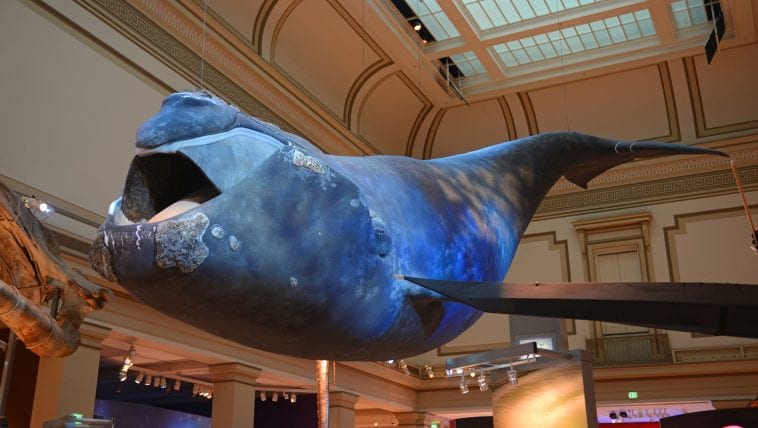[Originally published as Whale Evolution Nightmare]
In 1620, colonial settlers, William Bradford and Edward Winslow sent out a business prospectus describing the North American coast:
Cape Cod was like to be a place of good fishing, for we saw daily great whales, of the best kind for oil and bone.
The American whaling industry had begun. Two hundred years later, New England was the premier whaling center of the world. More than 10,000 men set-sail on whaling ships in 1857 from New Bedford, Massachusetts alone. Certainly, whale evolution or extinction was not a popular topic.
Within the next 100 years, right whales, the same species as Herman Melville’s mythical Moby Dick, living in the north Atlantic had seen their population decimated, causing the whaling industry to hunt deeper into the ocean and eventually into the southern Atlantic. Since fewer than 100 individuals were known to exist by 1935, right whale hunting was globally banned in 1937. While the population was estimated to have finally increased to 500 in 2013, a Florida research team has uncovered that a genetic mutation is now forcing the whale population into extinction—a whale evolution nightmare.
Single Gene Mutation
In search for a biological explanation for the declining whale population, a research team lead by Lorian E. Schweikert of the Florida Institute of Technology, cloned and sequenced the whale gene that codes for light-sensitive photoreceptive proteins known as opsins. These proteins in the retina’s photoreceptor cells act to mediate the conversion of light into electrochemical signals—the first step in the visual transduction cascade.
The team published their results in the Journal of Comparative Neurology (2016) entitled
Evolutionary loss of cone photoreception in balaenid whales reveals circuit stability in the mammalian retina
As ScienceDaily explains, “the normal light-detecting proteins in cone photoreceptor cells are missing in these whales, demonstrating for the first time the complete loss of cone-based light detection in any mammal.”
Nearly all vertebrates contain both rod and cone photoreceptor cells in the retina—cells that play distinct yet complementary roles. While rod photoreceptors support dim-light vision, the cone photoreceptor cells act to provide vision in bright-light conditions.
Scientists have found that a genetic mutation in the eyes of right whales hampers their ability to see in bright light may make them more susceptible to fatal entanglements in fishing gear, one of the major causes of death for this critically endangered mammal.
In the article “Whales Extinction Reason: Blame Genetic Mutation,” science writer Rodney Rafols explains the reason why:
“The light-detecting proteins in whale’s cone photoreceptor cells in the eyes are missing.”
The net effect of mutations in a single gene is loss of vision.
Original Mutation Theory
Gene mutations were originally envisioned as the driving force of evolution. In a vacuum of scientific evidence, in 1937, American geneticist Theodosius Dobzhansky speculated on a tenet for a new theory of evolution:
Mutations and chromosomal changes … constantly and unremittingly supply the raw materials for evolution.
Dobzhansky is credited with the legendary statement: “Nothing in biology makes sense except in the light of evolution.” A mosaic medallion of his statement now resides on the floor of the main hall of the Jordan Hall of Science, University of Notre Dame, a Catholic research university located adjacent to South Bend, Indiana.
The bold speculation took the evolution industry by storm. By mid-century, the theory was a standard staple in public school biology textbooks—a scientific fact. In the textbook, An Introduction to Biology (1957), Gaylord Simpson, curator of the American Museum of Natural History, advanced further the speculation:
Mutations are the ultimate raw materials for evolution.
“By far the most important way in which chance influences evolution is the process of mutation,” Douglas J. Futuyma, of the State University of New York at Stony Brook, argued in 1983. “Mutation is, ultimately, the source of new genetic variations, and without genetic variation, there cannot be genetic change. Mutation is therefore necessary for evolution.”
The theory seemed to explain Darwin’s largest unresolved problem—the origin of new variations to produce new species. For Darwin, this problem was something yet to be resolved at some later date:
We are far too ignorant to speculate on the relative importance of the several known and unknown causes of variation.
Mutations Under the Microscope
By conceptualizing genetic mutations as the source of variation, Darwin’s unresolved dilemma was finally solved. Mutations provided the evolution industry with a theoretical mechanism to account for the origin of new variations resulting in the formation of new species. Then came advanced science technologies—specifically, electron microscopy only a few years after James Watson and Francis Crick deduced the structure of DNA in 1952 using X-ray defraction.
Incorporating scientific evidence from the new technological advances into the theory of evolution, however, faced a significant prejudice – obstacles challenging the status quo. Theodosius Dobzhansky was eventually nominated for a Nobel Prize “for the discovery that mutations can be induced by X-rays,” coming full-circle on his original speculation.
In his 1955 book Evolution, Genetics and Man, Dobzhansky finally conceded to the error of his earlier speculations:
Most mutants which arise in any organism are more or less disadvantageous to their possessors.
With new scientific evidence from the new technologies, things began to look very different. In their 2002 book Acquiring Genomes: A Theory of the Origins of Species, evolutionists Lynn Margulis, from the University of Massachusetts Amherst, and Dorion Sagan, the son of Carl Sagan, explain:
Many ways to induce mutations are known but none leads to new organisms. Mutation accumulation does not lead to new species or even to new organs or new tissues …even professional evolutionary biologists are hard put to find mutations, experimentally induced or spontaneous, that lead in a positive way to evolutionary change.
“One spur to research on mutations was the hope that an accumulation of these might lead to a new species,” opined Italian geneticist Giuseppe Sermonti. “But this never happened.”
Whale Evolution Nightmare
Genetic mutations, once considered the savior from Darwin’s dilemma, have emerged as a biological nightmare for the evolution industry. According to the U.S. National Library of Medicine’s online Genetics Home Reference Handbook,
Mutations have very serious effects, [and] they are incompatible with life.
Today, genetic mutations in humans have been associated with more than 4,000 specific known diseases. According to Encyclopedia Britannica,
About 30 percent of all postnatal infant mortality in developed countries is due to genetic disease; 30 percent of pediatric and 10 percent of adult hospital admissions can be traced to a predominantly genetic cause.
Unfortunately, the mutations in this single whale gene are anticipated to eventually lead to the species’ extinction—a whale nightmare. Evidence for mutations to produce new variations, new transitional links, and new species simply does not exist. A distinct link, however, does exist between genetic mutations and extinction.
Contrary to Darwin’s theory, not only is there a lack of evidence for whale evolution as demonstrated by no know common ancestry and no known transitional links, in the more than 2,000 closely-related opsin genes identified no known transitional links do not exist. Opsins are uniquely species specific.
The whale evolution nightmare is emblematic of the dying evolution industry.
Genesis
Despite a flood of challenges since the publication of The Origin of Species and more than 150 years of unprecedented scientific efforts in the history of mankind to prove otherwise, the evidence examined in nature tooled with unprecedented technology continues to be compatible with the Genesis record written by Moses.
Robert Boyle (1627-1691), fellow of the Royal Society, regarded as the first modern chemist, and founder of Boyle’s Law declared:
In the Bible the ignorant may learn all requisite knowledge, and the most knowing may learn to discern their ignorance.
Evolution, once a theory in crisis, is now in crisis without even a cohesive unifying theory.
Biological evolution exists only as a philosophy, not a science.







